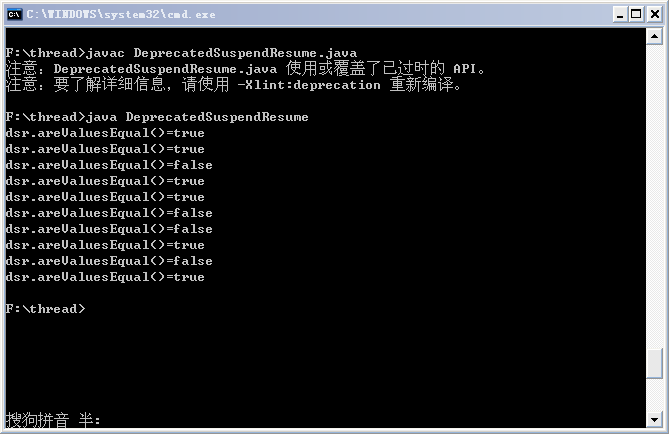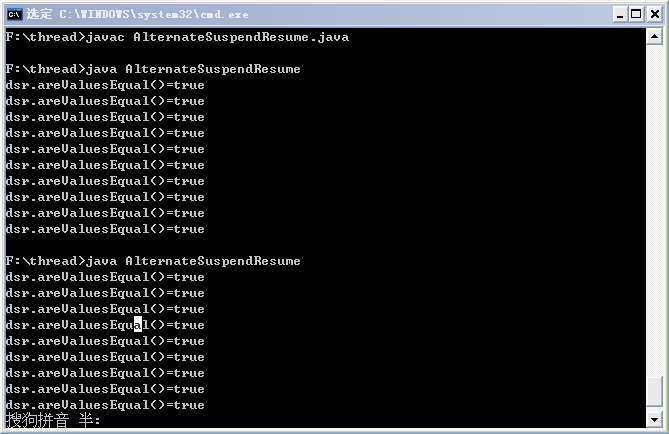Thread 的API中包含兩個(gè)被淘汰的方法,它們用于臨時(shí)掛起和重啟某個(gè)線程,這些方法已經(jīng)被淘汰,因?yàn)樗鼈兪遣话踩模环€(wěn)定的。如果在不合適的時(shí)候掛起線程(比如,鎖定共享資源時(shí)),此時(shí)便可能會(huì)發(fā)生死鎖條件——其他線程在等待該線程釋放鎖,但該線程卻被掛起了,便會(huì)發(fā)生死鎖。另外,在長時(shí)間計(jì)算期間掛起線程也可能導(dǎo)致問題。
下面的代碼演示了通過休眠來延緩運(yùn)行,模擬長時(shí)間運(yùn)行的情況,使線程更可能在不適當(dāng)?shù)臅r(shí)候被掛起:
|
1
2
3
4
5
6
7
8
9
10
11
12
13
14
15
16
17
18
19
20
21
22
23
24
25
26
27
28
29
30
31
32
33
34
35
36
37
38
39
40
41
42
43
44
45
46
47
48
49
50
51
52
53
54
55
56
57
58
|
public class DeprecatedSuspendResume extends Object implements Runnable{ //volatile關(guān)鍵字,表示該變量可能在被一個(gè)線程使用的同時(shí),被另一個(gè)線程修改 private volatile int firstVal; private volatile int secondVal; //判斷二者是否相等 public boolean areValuesEqual(){ return ( firstVal == secondVal); } public void run() { try{ firstVal = 0; secondVal = 0; workMethod(); }catch(InterruptedException x){ System.out.println("interrupted while in workMethod()"); } } private void workMethod() throws InterruptedException { int val = 1; while (true){ stepOne(val); stepTwo(val); val++; Thread.sleep(200); //再次循環(huán)錢休眠200毫秒 } } //賦值后,休眠300毫秒,從而使線程有機(jī)會(huì)在stepOne操作和stepTwo操作之間被掛起 private void stepOne(int newVal) throws InterruptedException{ firstVal = newVal; Thread.sleep(300); //模擬長時(shí)間運(yùn)行的情況 } private void stepTwo(int newVal){ secondVal = newVal; } public static void main(String[] args){ DeprecatedSuspendResume dsr = new DeprecatedSuspendResume(); Thread t = new Thread(dsr); t.start(); //休眠1秒,讓其他線程有機(jī)會(huì)獲得執(zhí)行 try { Thread.sleep(1000);} catch(InterruptedException x){} for (int i = 0; i < 10; i++){ //掛起線程 t.suspend(); System.out.println("dsr.areValuesEqual()=" + dsr.areValuesEqual()); //恢復(fù)線程 t.resume(); try{ //線程隨機(jī)休眠0~2秒 Thread.sleep((long)(Math.random()*2000.0)); }catch(InterruptedException x){ //略 } } System.exit(0); //中斷應(yīng)用程序 } } |
某次運(yùn)行結(jié)果如下:

從areValuesEqual()返回的值有時(shí)為true,有時(shí)為false。以上代碼中,在設(shè)置firstVal之后,但在設(shè)置secondVal之前,掛起新線程會(huì)產(chǎn)生麻煩,此時(shí)輸出的結(jié)果會(huì)為false(情況1),這段時(shí)間不適宜掛起線程,但因?yàn)榫€程不能控制何時(shí)調(diào)用它的suspend方法,所以這種情況是不可避免的。
當(dāng)然,即使線程不被掛起(注釋掉掛起和恢復(fù)線程的兩行代碼),如果在main線程中執(zhí)行asr.areValuesEqual()進(jìn)行比較時(shí),恰逢stepOne操作執(zhí)行完,而stepTwo操作還沒執(zhí)行,那么得到的結(jié)果同樣可能是false(情況2)。
下面我們給出不用上述兩個(gè)方法來實(shí)現(xiàn)線程掛起和恢復(fù)的策略——設(shè)置標(biāo)志位。通過該方法實(shí)現(xiàn)線程的掛起和恢復(fù)有一個(gè)很好的地方,就是可以在線程的指定位置實(shí)現(xiàn)線程的掛起和恢復(fù),而不用擔(dān)心其不確定性。
對(duì)于上述代碼的改進(jìn)代碼如下:
|
1
2
3
4
5
6
7
8
9
10
11
12
13
14
15
16
17
18
19
20
21
22
23
24
25
26
27
28
29
30
31
32
33
34
35
36
37
38
39
40
41
42
43
44
45
46
47
48
49
50
51
52
53
54
55
56
57
58
59
60
61
62
63
64
65
66
67
68
69
70
71
72
73
74
75
76
77
78
79
80
81
82
83
84
85
|
public class AlternateSuspendResume extends Object implements Runnable { private volatile int firstVal; private volatile int secondVal; //增加標(biāo)志位,用來實(shí)現(xiàn)線程的掛起和恢復(fù) private volatile boolean suspended; public boolean areValuesEqual() { return ( firstVal == secondVal ); } public void run() { try { suspended = false; firstVal = 0; secondVal = 0; workMethod(); } catch ( InterruptedException x ) { System.out.println("interrupted while in workMethod()"); } } private void workMethod() throws InterruptedException { int val = 1; while ( true ) { //僅當(dāng)賢臣掛起時(shí),才運(yùn)行這行代碼 waitWhileSuspended(); stepOne(val); stepTwo(val); val++; //僅當(dāng)線程掛起時(shí),才運(yùn)行這行代碼 waitWhileSuspended(); Thread.sleep(200); } } private void stepOne(int newVal) throws InterruptedException { firstVal = newVal; Thread.sleep(300); } private void stepTwo(int newVal) { secondVal = newVal; } public void suspendRequest() { suspended = true; } public void resumeRequest() { suspended = false; } private void waitWhileSuspended() throws InterruptedException { //這是一個(gè)“繁忙等待”技術(shù)的示例。 //它是非等待條件改變的最佳途徑,因?yàn)樗鼤?huì)不斷請(qǐng)求處理器周期地執(zhí)行檢查, //更佳的技術(shù)是:使用Java的內(nèi)置“通知-等待”機(jī)制 while ( suspended ) { Thread.sleep(200); } } public static void main(String[] args) { AlternateSuspendResume asr = new AlternateSuspendResume(); Thread t = new Thread(asr); t.start(); //休眠1秒,讓其他線程有機(jī)會(huì)獲得執(zhí)行 try { Thread.sleep(1000); } catch ( InterruptedException x ) { } for ( int i = 0; i < 10; i++ ) { asr.suspendRequest(); //讓線程有機(jī)會(huì)注意到掛起請(qǐng)求 //注意:這里休眠時(shí)間一定要大于 //stepOne操作對(duì)firstVal賦值后的休眠時(shí)間,即300ms, //目的是為了防止在執(zhí)行asr.areValuesEqual()進(jìn)行比較時(shí), //恰逢stepOne操作執(zhí)行完,而stepTwo操作還沒執(zhí)行 try { Thread.sleep(350); } catch ( InterruptedException x ) { } System.out.println("dsr.areValuesEqual()=" + asr.areValuesEqual()); asr.resumeRequest(); try { //線程隨機(jī)休眠0~2秒 Thread.sleep( ( long ) (Math.random() * 2000.0) ); } catch ( InterruptedException x ) { //略 } } System.exit(0); //退出應(yīng)用程序 } } |
運(yùn)行結(jié)果如下:

線程掛起的位置不確定main線程中執(zhí)行asr.areValuesEqual()進(jìn)行比較時(shí),恰逢stepOne操作執(zhí)行完,而stepTwo操作還沒執(zhí)行)asr.areValuesEqual()操作前,讓main線程休眠450ms(>300ms),如果掛起請(qǐng)求發(fā)出時(shí),新線程正執(zhí)行到或即將執(zhí)行到stepOne操作(如果在其前面的話,就會(huì)響應(yīng)掛起請(qǐng)求,從而掛起線程),那么在stepTwo操作執(zhí)行前,main線程的休眠還沒結(jié)束,從而main線程休眠結(jié)束后執(zhí)行asr.areValuesEqual()操作進(jìn)行比較時(shí),stepTwo操作已經(jīng)執(zhí)行完,因此也不會(huì)出現(xiàn)輸出結(jié)果為false的情況。
可以將ars.suspendRequest()代碼后的sleep代碼去掉,或?qū)⑿菝邥r(shí)間改為200(明顯小于300即可)后,查看執(zhí)行結(jié)果,會(huì)發(fā)現(xiàn)結(jié)果中依然會(huì)有出現(xiàn)false的情況。如下圖所示:

總結(jié):線程的掛起和恢復(fù)實(shí)現(xiàn)的正確方法是:通過設(shè)置標(biāo)志位,讓線程在安全的位置掛起
終止線程
終止線程的替代方法:同樣是使用標(biāo)志位,通過控制標(biāo)志位來終止線程。
以上所述是小編給大家介紹的Java 并發(fā)編程之線程掛起、恢復(fù)與終止,希望對(duì)大家有所幫助,如果大家有任何疑問請(qǐng)給我留言,小編會(huì)及時(shí)回復(fù)大家的。在此也非常感謝大家對(duì)服務(wù)器之家網(wǎng)站的支持!
原文鏈接:http://www.cnblogs.com/web424/p/6807319.html















